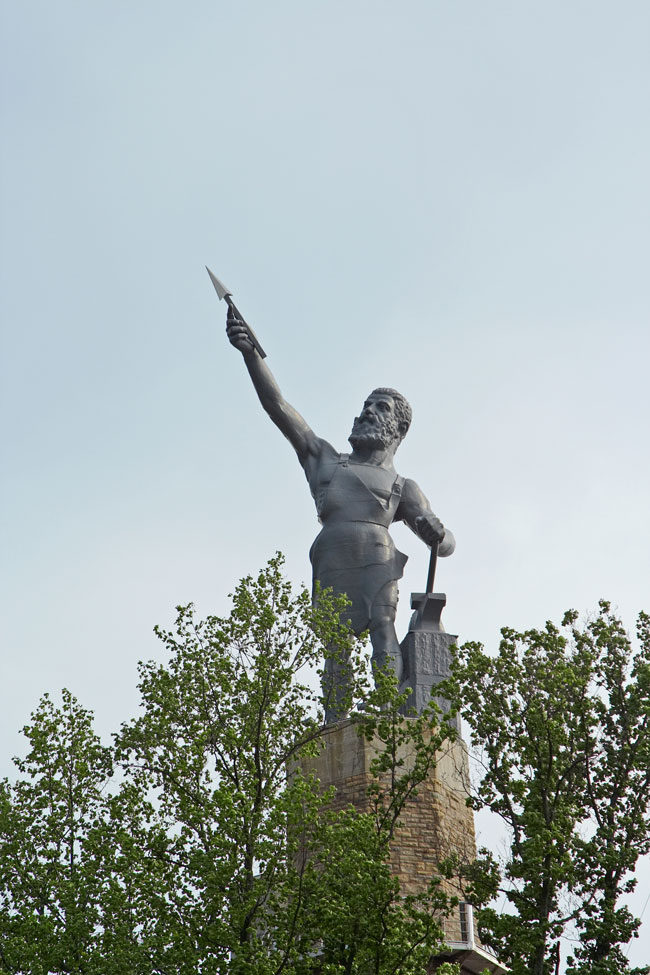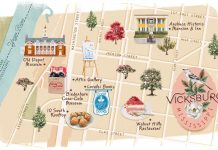 Whatever moves you—food, history, or working up a sweat—you’ll discover it in Birmingham. Alabama’s biggest city is booming, snagging national honors for its chefs, parks, and artful reinvention.
Whatever moves you—food, history, or working up a sweat—you’ll discover it in Birmingham. Alabama’s biggest city is booming, snagging national honors for its chefs, parks, and artful reinvention.
The city has finally shaken—but not forgotten—the legacy of its troubled past. Today, it’s in the midst of a renaissance, emerging as a buzzy, forward-thinking place and making its mark as one of the hottest destinations in the South.
Amazing Eats
If you’re Birmingham bound, here’s a word of advice: Stop eating now. You’ll need quite an appetite to experience a food scene celebrated by everyone from Zagat to Thrillist, Bon Appetit to Esquire.
Set your sights higher than barbecue and meat-and-threes. Although you’ll discover plenty of outstanding Southern fare, the city’s kitchens offer so much more. For the full experience, start at the source: Highlands Bar and Grill, a James Beard Foundation seven-time finalist for best restaurant in the nation (the food world’s equivalent to a Best Picture Oscar). Alabama native and executive chef Frank Stitt began his career at Chez Panisse in Berkeley, California, the shrine of farm-to-table dining, and he made his name here in 1982 with the then-radical idea of using refined French cooking techniques to prepare down-home Southern cuisine (think beef cheeks and dumplings). Highlands is the kind of place executive recruiters bring job candidates to in order to prove Birmingham is no Mayberry. If you like Highlands, peek in next door at Stitt’s Chez Fonfon, a laid-back French bistro with incredible mussels and frites, as well as nearby Bottega, a breezy Italian trattoria known for wood-fired pizzas.
It isn’t overstating it to say Stitt created Birmingham’s current food scene. His kitchen trained an all-star lineup of the city’s chefs, starting with Chris Hastings, whose Hot and Hot Fish Club gained national fame in 2012 when he bested Bobby Flay to win Iron Chef, a victory the Birmingham News touted the next day on the front page. Reserve a seat at the chef’s counter for dinner and a culinary show—on some nights, the fast-paced action makes it the best seat in the city. And if it’s in season, order the heirloom tomato salad topped with locally sourced bacon (which, as any Southerner knows, makes everything better).

Hastings is also the mastermind behind Ovenbird, which has critics flying in from New York to taste small-plate wonders like flaming beef tallow, which arrives burning like a candle, accompanied by chunks of baguette to sop up the tasty drippings.
Ovenbird is located next to Pepper Place Market, ground zero for cooks and noshers alike. Visit on Saturday morning, when local and visiting celeb chefs dazzle crowds with culinary demonstrations and weekend cooks snag fresh produce and homemade ice cream sammies from the Big Spoon Creamery trike.
For more to-go delights, take a short trip to Mountain Brook, a cozy community of shopping villages and graceful Southern homes. Stone Hollow Farmstead’s Pantry, a city outpost of the suburban goat dairy and creamery, sells cheeses, soups, and jams. And don’t miss the wine blending room in the new Grand Bohemian Hotel, where a sommelier teaches guests to combine whites or reds into customized elixirs that are bottled, corked, and marked with a personalized label. The blending room is next door to a cooking classroom run by Clif Holt, the chef behind another city standout restaurant, Little Savannah.

Cary Norton
Just a few blocks away, there’s Ollie Irene, a storefront gastropub started by another Stitt protégé, Chris Newsome. Homemade pickles and charcuterie delight the palate, especially when washed down with custom cocktails (don’t miss Ollie’s Old Fashioned, made with Bulleit rye whiskey, orange, muddled cherry, bitters, and a dash of maple syrup). If you approve, add the $15 “Kitchen Appreciation” line item to your tab, which buys a beer for every worker in the galley.
Don’t leave the Mountain Brook neighborhood without checking out Birmingham Botanical Garden, which features a Japanese garden lifted from Kyoto. And if the garden whets your appetite for other cultural attractions, make a note to visit the Birmingham Museum of Art, a free museum that’s home to the largest collection of Wedgwood ceramics outside England, as well as folk art and photography.
Layered Legacies
The images cannot be forgotten: civil rights marchers attacked by police dogs, children pinned to the walls of buildings by high-pressure fire hoses, a black church bombed—and four young girls killed—during Sunday school on a September morning a half-century ago. In 1963, Alabama became the flashpoint of the modern civil rights movement, and when those pictures appeared around the globe, Birmingham saw its reputation seemingly stained forever.

Ted Tucker
But here’s something remarkable: The city hasn’t hidden from its past. In fact, there’s perhaps no better place in the world to learn about America’s tumultuous struggle to end segregation than Birmingham. And given the issues of racial discrimination the country continues to face, there’s arguably no better time to visit.

Birmingham became one of the first cities to commemorate the era when it opened the Birmingham Civil Rights Institute in 1992. Its unblinking exhibits trace the rise of the Ku Klux Klan and document the relentless attacks that earned the city the nickname “Bombingham.” Visitors walk past a charred bus that carried Freedom Riders and pause to watch news clips that shocked the nation. There’s also the actual barred door from the city jail cell where Martin Luther King Jr. wrote his “Letter from Birmingham Jail,” a call for nonviolent protest.
Across the street, take a free cell phone audio tour of Kelly Ingram Park (dial 205-307-5455), where menacing statues show police dogs attacking peaceful protesters during the Children’s March of 1963 and walking trails retrace the path of protesters. Just a few months after the Children’s Crusade, the world’s attention again turned to this corner when a bomb exploded on a Sunday morning at the 16th Street Baptist Church, killing four girls. Now a National Historic Landmark, the church welcomes guests for sanctuary tours and offers a small commemorative display in the basement.
While you’re in the area, stop by Nelson Brother’s Cafe (205-254-9098), a soul food restaurant and bakery that served marchers a half-century ago. Standouts include grits and salmon croquettes, though what you’ll remember is the friendly atmosphere.
Birmingham marks its history elsewhere throughout the city; the airport, for example, is now named for the Reverend Fred Shuttlesworth, a key player in Birmingham’s struggles. The minister survived several murder attempts and has been called the bravest man in the civil rights movement. A permanent display tells his inspiring story and makes the airport worth a visit, even if you’re not flying.

Shutterstock
If Shuttlesworth emerged as the hero, the city’s undeniable villain was Eugene “Bull” Connor, the public safety commissioner who became the face of racism, putting tanks on the streets and ordering attacks on children. A former baseball announcer, Connor fell from grace when he was caught having an affair with his secretary at the Tutwiler Hotel. Unfortunately for the city, the scandal wasn’t enough to end his career, but the historic inn has been lovingly restored and makes a great base for visitors.
Birmingham has other stories too, of course, many of them dating back to the nineteenth century. The city was developed after the Civil War by industrialists who saw that a fortune could be made from the valley’s deposits of coal, limestone, and iron ore—the raw ingredients of iron and steel. Soon smokestacks sprouted like mushrooms and the city boomed. While the region still has strong industrial ties, its fortunes are now centered around the University of Alabama-Birmingham, one of the nation’s top medical research centers. Still, it’s fascinating to revisit Birmingham’s ‘iron age’ at Sloss Furnaces, where visitors to the National Historic Landmark are wowed by 400-ton blast furnaces and afforded the chance to learn more about the operation, as well as its segregated company town, in an on-site museum.
Iron also inspired the erecting of Vulcan, a fifty-ton statue of the Roman god of the forge situated atop Red Mountain. (No, it’s not your imagination: He’s not wearing pants, and the town of Homewood forever jokes about being mooned by the giant.) Vulcan Park is worth a visit for the views from the 1,025-foot mountaintop alone, but an innovative history museum on site—and a cheeky gift shop selling bobble-butt figurines—seals the deal. Past exhibits have examined unexpected subjects such as the role of the city’s Greek community in developing Birmingham’s first restaurants, many of which remain in operation. [Notable establishments include Southside’s Fish Market, known for its fresh Gulf oysters and Athenian snapper, and Niki’s West, a famed meat-and-three serving several dozen vegetables daily and a legendary banana cream pie.]
Active Pursuits
Before you make the mistake of calling Birmingham a sleepy Southern town, pay a visit to Railroad Park. Since opening in 2010, the nineteen-acre greenspace in Southside near the University of Alabama-Birmingham has been a whirlwind of activity. Any given afternoon, you might find scores of lycra-clad office workers sweating through a free Zumba class, hippie throwbacks tapping away in a drum circle, or Ironman wannabes tackling the fitness trail.

The park has also sparked nearby redevelopment. In 2013, it was joined by neighboring Regions Field, home of the Birmingham Barons baseball team. In just a few short years, the park has set Minor League attendance records. After taking in a game, step across the street to Good People Brewing Company, where you’ll find a warehouse bar and a side yard littered with cornhole boards, Frisbee golf baskets, and a giant Jenga game. Drink offerings vary, but it’s hard to go wrong with the brewery’s own American Brown Ale, a hoppy brew with a subtle chocolaty finish.
From Good People, head around the corner to the Negro Southern League Museum, where you can step up to a plate and face a pitch from a hologram of Satchel Paige, an Alabama native and Baseball Hall of Famer who some regard as the best pitcher in the history of the game. The new museum pays homage to the segregated league that brought greats like Hank Aaron, Willie Mays, and Jackie Robinson through Birmingham. Baseball fans will also want to visit West End’s Rickwood Field; the lovingly restored 1910 Minor League park is the oldest professional baseball stadium still operating in the country and is open year-round for tours.
Fans of more extreme sports, specifically mountain biking, will want to test their mettle on a ride along Oak Mountain State Park’s Double Oak Trail, which has long held a spot on the International Mountain Bike Association’s list of “epic” must-rides around the world. Having too much fun to leave the park? Hire an outfitter to pitch you a tentsile tent—a cross between a hammock and a treehouse—for a memorable night outdoors.
You’ll find more two-wheel fun at Barber Vintage Motorsports Museum, which houses the world’s largest motorcycle collection. Even those who don’t know a Harley from a Honda will appreciate the building, a modern-art masterpiece inspired by the Guggenheim.

Birmingham’s Zyp bike share program offers even more evidence the city is alive and active. The program operates forty kiosks with 400 bikes between them and even rents electric-assist models for those who need a little help making it up hills. Those bikes will no doubt fill the downtown Rotary Trail, Birmingham’s version of New York’s High Line, scheduled to open this spring. Be sure to pedal past LightRails, a neon-lit tunnel near Rotary Trail that has become an Instagram favorite; its cascading rainbows of color flash through the underpass nightly.
From there, it’s an easy ride to the buzzing Avondale neighborhood, its namesake brewery, and dining options such as Hotbox, an Airstream trailer permanently parked behind Parkside Cafe (205-595-0920) that serves memorable drunken noodles and shrimp potstickers. Other neighborhood offerings include Melt, specializing in grilled cheese, and Saturn, certain to appeal to diners with a weakness for all things retro. The space-age coffee shop, bar, and music venue sponsors vintage video game nights featuring classic systems such as Nintendo, Atari, and PlayStation. If you happen to be here on a Sunday, check out the cereal buffet, featuring dozens of sugary favorites, from Lucky Charms to Cap’n Crunch, for $2 a bowl.
You’ll appreciate those carbs if you’re a hiker with plans to visit Red Mountain Park another new preserve just twenty minutes from Avondale. Situated on land that once belonged to U.S. Steel, the park’s trails pass historic mining structures and four adventure courses, including a handicap-accessible zip line and a treetop experience that looks like something out of The Hunger Games.

Michael Clemmer
If you get your thrills on greens, check out the state’s famed Robert Trent Jones Golf Trail. Birmingham’s stop, Ross Bridge, measures 8,191 yards, making it the one of the longest courses in the world. The adjacent AAA Four-Diamond Renaissance Birmingham Ross Bridge Golf Resort and Spa seems like a Scottish castle transported to the Alabama hills, complete with a resident bagpipe player. After a round of golf, you deserve some time in the hotel’s 12,000-square-foot spa. Opt for the dual massage—two therapists kneading your muscles at once—because after experiencing all of Birmingham, it just might take an extra pair of hands to get the job done.
























